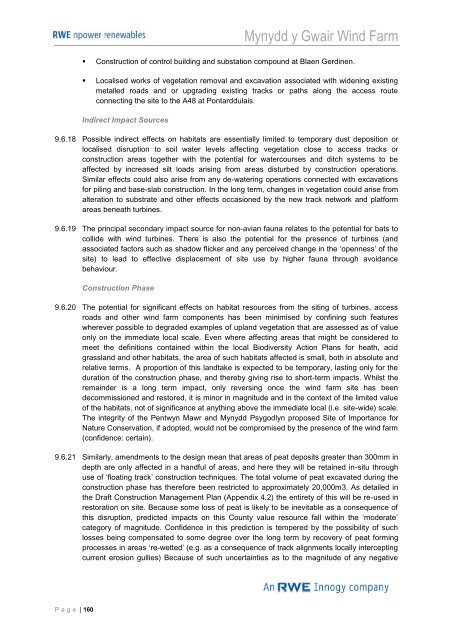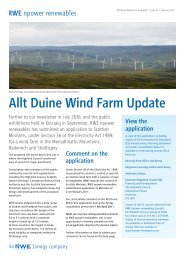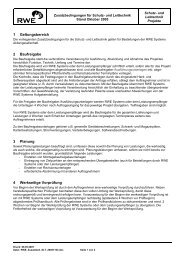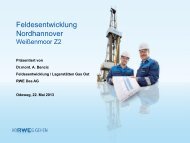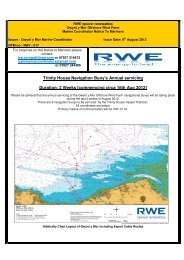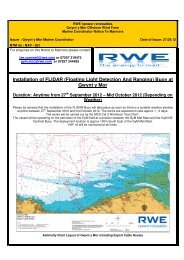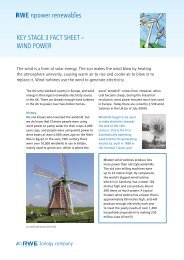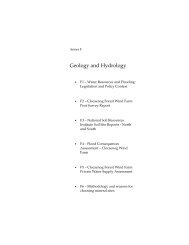Mynydd y Gwair Wind Farm - RWE.com
Mynydd y Gwair Wind Farm - RWE.com
Mynydd y Gwair Wind Farm - RWE.com
Create successful ePaper yourself
Turn your PDF publications into a flip-book with our unique Google optimized e-Paper software.
P a g e | 160<br />
<strong>Mynydd</strong> y <strong>Gwair</strong> <strong>Wind</strong> <strong>Farm</strong><br />
Construction of control building and substation <strong>com</strong>pound at Blaen Gerdinen.<br />
Localised works of vegetation removal and excavation associated with widening existing<br />
metalled roads and or upgrading existing tracks or paths along the access route<br />
connecting the site to the A48 at Pontarddulais.<br />
Indirect Impact Sources<br />
9.6.18 Possible indirect effects on habitats are essentially limited to temporary dust deposition or<br />
localised disruption to soil water levels affecting vegetation close to access tracks or<br />
construction areas together with the potential for watercourses and ditch systems to be<br />
affected by increased silt loads arising from areas disturbed by construction operations.<br />
Similar effects could also arise from any de-watering operations connected with excavations<br />
for piling and base-slab construction. In the long term, changes in vegetation could arise from<br />
alteration to substrate and other effects occasioned by the new track network and platform<br />
areas beneath turbines.<br />
9.6.19 The principal secondary impact source for non-avian fauna relates to the potential for bats to<br />
collide with wind turbines. There is also the potential for the presence of turbines (and<br />
associated factors such as shadow flicker and any perceived change in the „openness‟ of the<br />
site) to lead to effective displacement of site use by higher fauna through avoidance<br />
behaviour.<br />
Construction Phase<br />
9.6.20 The potential for significant effects on habitat resources from the siting of turbines, access<br />
roads and other wind farm <strong>com</strong>ponents has been minimised by confining such features<br />
wherever possible to degraded examples of upland vegetation that are assessed as of value<br />
only on the immediate local scale. Even where affecting areas that might be considered to<br />
meet the definitions contained within the local Biodiversity Action Plans for heath, acid<br />
grassland and other habitats, the area of such habitats affected is small, both in absolute and<br />
relative terms. A proportion of this landtake is expected to be temporary, lasting only for the<br />
duration of the construction phase, and thereby giving rise to short-term impacts. Whilst the<br />
remainder is a long term impact, only reversing once the wind farm site has been<br />
de<strong>com</strong>missioned and restored, it is minor in magnitude and in the context of the limited value<br />
of the habitats, not of significance at anything above the immediate local (i.e. site-wide) scale.<br />
The integrity of the Pentwyn Mawr and <strong>Mynydd</strong> Psygodlyn proposed Site of Importance for<br />
Nature Conservation, if adopted, would not be <strong>com</strong>promised by the presence of the wind farm<br />
(confidence: certain).<br />
9.6.21 Similarly, amendments to the design mean that areas of peat deposits greater than 300mm in<br />
depth are only affected in a handful of areas, and here they will be retained in-situ through<br />
use of „floating track‟ construction techniques. The total volume of peat excavated during the<br />
construction phase has therefore been restricted to approximately 20,000m3. As detailed in<br />
the Draft Construction Management Plan (Appendix 4.2) the entirety of this will be re-used in<br />
restoration on site. Because some loss of peat is likely to be inevitable as a consequence of<br />
this disruption, predicted impacts on this County value resource fall within the „moderate‟<br />
category of magnitude. Confidence in this prediction is tempered by the possibility of such<br />
losses being <strong>com</strong>pensated to some degree over the long term by recovery of peat forming<br />
processes in areas „re-wetted‟ (e.g. as a consequence of track alignments locally intercepting<br />
current erosion gullies) Because of such uncertainties as to the magnitude of any negative


